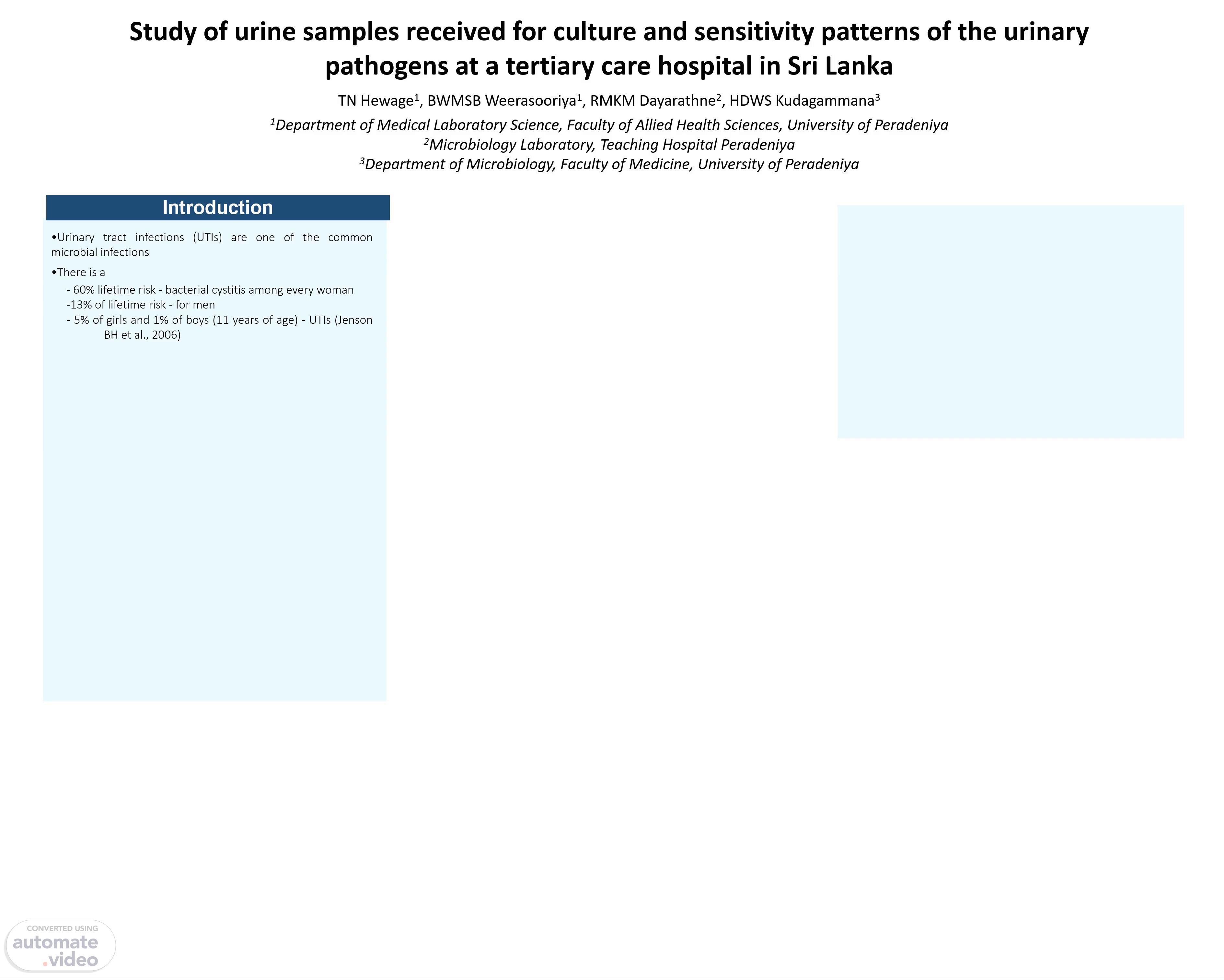Scene 1 (0s)
[Audio] This is the poster presentation on the topic of study of urine samples received for culture and sensitivity patterns of the urinary pathogens at a tertiary care hospital in Sri Lanka. Urinary tract infection are one of most common microbial infections all over the world. According to the available data, every women has 60% life time risk for having bacterial cystitis and for men, it's 13%. This study mainly focused on the impact of the clinical practices along with especially type of the urine samples and addressing of urinary pathogen epidemiology. Availability of information of sample storing in refrigerator also can be utilized to management failures and poor patient outcomes. Further, sample collection before starting antibiotics therapy also shows significant impact of final interpretation. Objectives General objective of this study is to evaluate the type & quality of urine samples received from inward & clinic patients and to detect antimicrobial resistance in pathogens. Methodology This is a descriptive cross-sectional study and stud setting is Teaching Hospital Peradeniya. Mainly research was conducted as 3 stages. 1st one is data collection and evaluating samples ·Urine container were evaluated with request forms evaluation was done using demographic data, date & time of sample collection & type of urine sample. Referring patient's BHTs and interviews were taken place in order to gather data regarding number of days that taken antibiotics before sample collection & prescribed antibiotics. ABST results & patient's culture outcomes were also recorded. As 2nd step, confirmation of identification of isolated organisms were done. Using F1 and F2 subcultures, then species level identification was done using biochemical tests. As 3rd step ABST resistance mechanism for carbapenemes was performed. Results Of 648 urine samples 1.18% of samples were not properly labeled. Total of 1008 of evaluated request forms, 15.18% were not included the demographic data properly. Only 32 request forms were included the both time and date of sample collection. 85.7% majority of samples were not included both time and date. 97.72% of request forms did not specify the type of sample like clean catch or catheter urine. Of 369 evaluations 99 samples were supposed to be catheter urine but not mentioned. According to evaluating BHTs, number of the day antibiotics were taken, prior to culture out of 250 only 95 of urine samples obtained prior to antibiotics and 61% of samples have been collected during ongoing antibiotics intake. When considering culture outcomes out of 1017 patients, 48.87% have shown no culture outcomes and also 18.58% of patients showed pure or significant growth. Out of 189 of positive results the highest isolation rate indicates as Escherichia coli and second most isolation rate indicated as Klebsiella pneumonia. Out of 14 of Meropenem resistant isolates, 28.57% were serine carbepenemase producers and 14.29% were Metallo- beta-lactamase producers. Storing urine samples in room temperature to increase possibility of multiplying the organisms. Therefore, mistakenly concluded as positive which is not reflecting actual root causes and will lead to misinterpretations. On the other hand, unless otherwise are most uninfected but colonized catheter system can be indicated positive outcomes for test results. In short, if request form emphasize as catheter urine, it makes interpretation easier. In conclusion, uropathogen isolation rates are similar to local and global patterns but, carbapenem resistance rate shows a rising trend. There is a suboptimal utilization of urine culture facilities in clinical application. Further evaluation to improve, timing of collecting urine samples before starting antibiotics, details.
